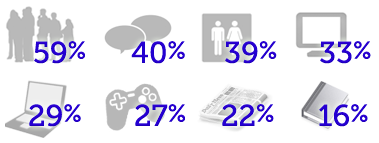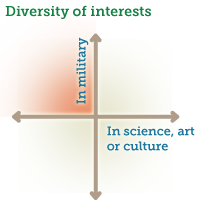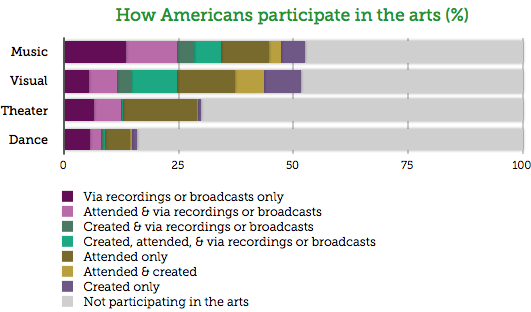Community Embraces New Word Game at Mid-Year Play Day This past Sunday, families at Takoma Park’s Seventh Annual Mid-Year Play Day had the opportunity to experience OtherWordly for the first time. Our educational language game drew curious children and parents to our table throughout the afternoon. Words in Space Several children gathered around our iPads […]
Read moreCategory: Research
 Wikipedia has 4,362,397 articles in English. But how many of those are seriously encyclopedic, and what are the most important articles?
Wikipedia has 4,362,397 articles in English. But how many of those are seriously encyclopedic, and what are the most important articles?
We’ve been looking closely at Wikipedia for an upcoming app. We wanted to know the most important articles. We calculated an importance score for every article, based on how richly linked a Wikipedia article is within Wikipedia (the number and quality of links to a page), how many languages an article has been translated into, the brevity of the title, how popular an articles is (web hits), and the number of citations/references of an article (scholarliness).
The following are our results. This is an arbitrary, but interesting ranking, so we wanted to share it: (more…)
Smartphones (e.g., the iPhone or Android) are commonplace, and education outreach projects need make use of this reality. People use their smartphones while doing all kinds of things. For example:

(Left to right, top: while waiting in line, socializing, in the bathroom, while watching TV; bottom: while using a computer, playing video games, reading a paper, or a book.)
The most common place to use a smartphones is at home (93% of smartphone owners), but people use their smartphones all kinds of places: (more…)
The following were the twenty most visited art exhibitions of 2010: (more…)
 National security is a useful angle for presenting science, art and culture issues to disengaged or skeptical audiences.
National security is a useful angle for presenting science, art and culture issues to disengaged or skeptical audiences.
 Like any hook, such as sports or popular culture, military and national security themes broaden an audience for outreach. There are over 3.6M military personnel in the U.S., 1.9M spouses & kids of active duty members, and over 22M veterans, who also have families. (Stats on personnel & families, and veterans.)
Like any hook, such as sports or popular culture, military and national security themes broaden an audience for outreach. There are over 3.6M military personnel in the U.S., 1.9M spouses & kids of active duty members, and over 22M veterans, who also have families. (Stats on personnel & families, and veterans.)
There are several initiatives which are bridging the military world with the sciences and culture…
(more…)
 The growing field of digital humanities is hampered by a lack of motivation to share tools, and a lack of direct rewards from the academic establishment, says a new study published last month in the Digital Humanities Quarterly.
The growing field of digital humanities is hampered by a lack of motivation to share tools, and a lack of direct rewards from the academic establishment, says a new study published last month in the Digital Humanities Quarterly.
Digital humanities uses computers as part of research in arts and humanities. Computers are useless in isolation; they need software written to do interesting analyses. Some processing can be done using simple text processing tools to sort and count words. More complex research requires new tools (new computer programs) to be created. The study looked at the people who create those new tools. One key finding was that creating new software does little to help researcher’s careers.
Computers and the internet are an increasingly important way that Americans engage in the arts, says a new report from the National Endowment for the Arts. The first bar in the chart below is people consuming recorded or broadcast content:

 Tina Rosenberg wrote in a blog post for the NYTimes last week, about microconsignment, which is..
Tina Rosenberg wrote in a blog post for the NYTimes last week, about microconsignment, which is..
A way for village entrepreneurs to sell innovative and important products for which there is no established market — such as solar lamps, water purifiers, stoves and reading glasses — without having to take on debt. (more…)
In 2008, IDEA conducted a study about online experiences. The report (download PDF here) outlines key findings from surveys that explored factors that drive online experience as expressed by the three different subject groups – nonprofit organizations and cities, web designers and firms, and the general public. (more…)
Enriching the learning experience with interactivity. Students become disengaged and learn less when information is presented passively, such as through lectures or static text. Although your web site may contain a wealth of educational information, the way the information is presented may not be engaging your visitors. When learners aren’t engaged, they don’t assimilate the


 Metadata is a the glue that makes information useful. It is data about data. It could be a title, location, and camera settings for a photo; the history of a painting; the materials in a museum object; the authors of a journal article; or the time, date, and location of photo of a butterfly for a citizen science project. “Tags” added to blog posts, photos, or tweets are all a form of metadata, allowing others to quickly hone in on related items.
Metadata is a the glue that makes information useful. It is data about data. It could be a title, location, and camera settings for a photo; the history of a painting; the materials in a museum object; the authors of a journal article; or the time, date, and location of photo of a butterfly for a citizen science project. “Tags” added to blog posts, photos, or tweets are all a form of metadata, allowing others to quickly hone in on related items.